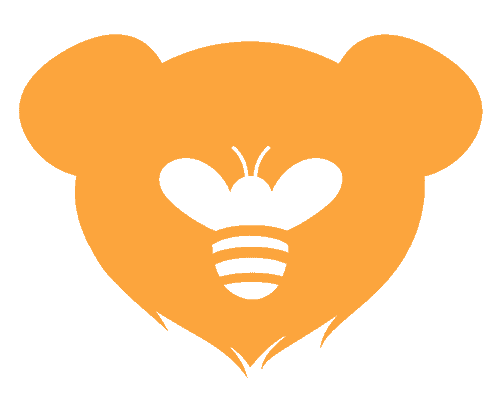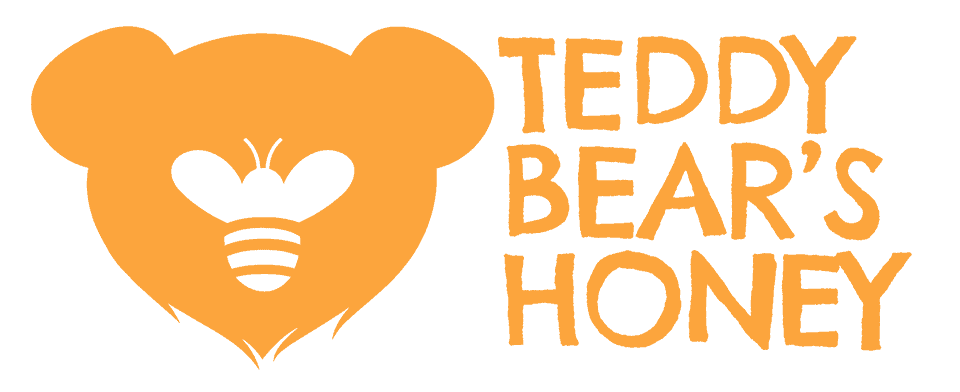The complex society and division of labor in a beehive are detailed and intricate, but one particular bee in the hive has only one function. The drone bee is an integral member of the colony, and bee swarms would not be able to survive without the drone. We will take a deeper, fascinating look at the drone bee and the role it has to play in the survival of the colony.
Drones are male honey bees whose sole function is to mate and pass on the genes from the queen of their own colony. The drone will not mate with the resident queen in the colony but will embark on mating flights to reproduce with a virgin queen from a different colony, ensuring genetic diversity.
The drone bee has a low profile from a public perspective since the workers, and the queen bee receives the most accolades. The role of the workers and the queen are crucial to the survival of the bees colony, but the role of the drone is no less important.
Drone Bees In The Beehive
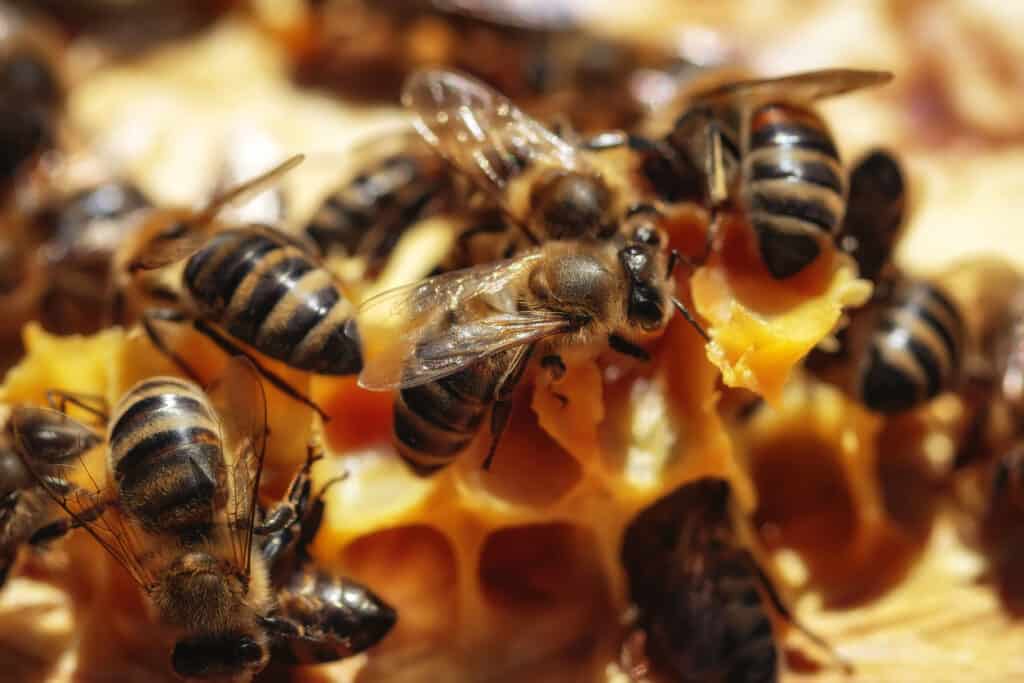
The majority of the bees in a honey bee colony are worker bees, who, along with the queen bee, are female bees. The drone bee is a male bee with limited function within the beehive itself.
The drone bee does not receive as much of the limelight in the colony as the workers and the queen. This is mostly since the drone has very little to do with the day-to-day running of the beehive, honey production, defense of the colony, or other housekeeping functions in the beehive.
People may see this as the drone as a “typical male” and not contributing to the upkeep or wellbeing of the colony. However, attributing human characteristics and behavior to animals and their society, known as anthropomorphism, is not a logical comparison.
The drones are not discriminated against in the colony due to the perceived lack of their contribution to the colony, except at the start of winter.
As we explore the role of the drone bee, we will see how they contribute to the colony and to the survival of the honey bee as a species.
How To Identify A Drone Bee
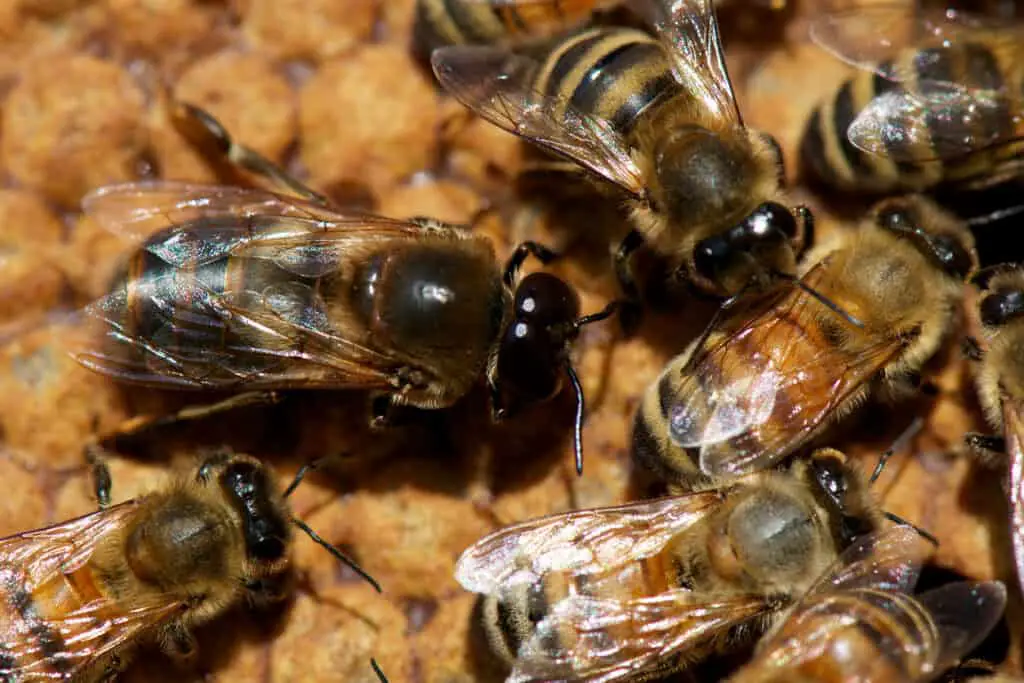
The drone bee is physically different from the worker bee and the queen, making it fairly easy to identify drones when you open your beehives.
Drone bees are chunky and have a blocky or squarish shape compared to the queen and the worker bees. Their appearance makes them look like a more robust, stronger bee than the worker and queen.
The drone is built to undertake long flights and requires the additional muscle and stamina to achieve these long flights and to compete with other drones.
Drones are often slightly darker in color than worker bees and the queen, although there is some variation in the color, with some drones being lighter than others.
The abdomen of the drone bee is rounded and blunt compared to the elongated tapering abdomens of the workers and the queen bee. The drone’s wings are considerably longer than those of other bees in the colony. The drone’s wings extend beyond the end of the abdomen and look less delicate than those of the worker bees.
The drone’s eyes are significantly larger than that of other bees and almost touch each other at the top of the drone’s head. Drones need the additional benefit of better vision to locate queen bees for mating and to accurately copulate with the queen during flight.
A drone does not have any pollen-collecting structures, nectar gathering equipment, or wax-producing glands. This lack of appropriate anatomy renders them incapable of participating in the work performed in the hive and collecting resources for the colony.
Can A Drone Bee Sting?
A drone bee does not have a stinger and is thus unable to sting to defend itself or defend the colony from attack by a predator or an intruder.
The lack of a stinger disqualifies the drone from performing any security-related function for the colony. This is a prime example of the efficiency of the division of labor within a bee colony.
The role of the male does not require gathering resources or defending the colony and therefore does not develop any anatomical equipment unnecessary to its function.
What Is The Purpose Of A Drone Bee
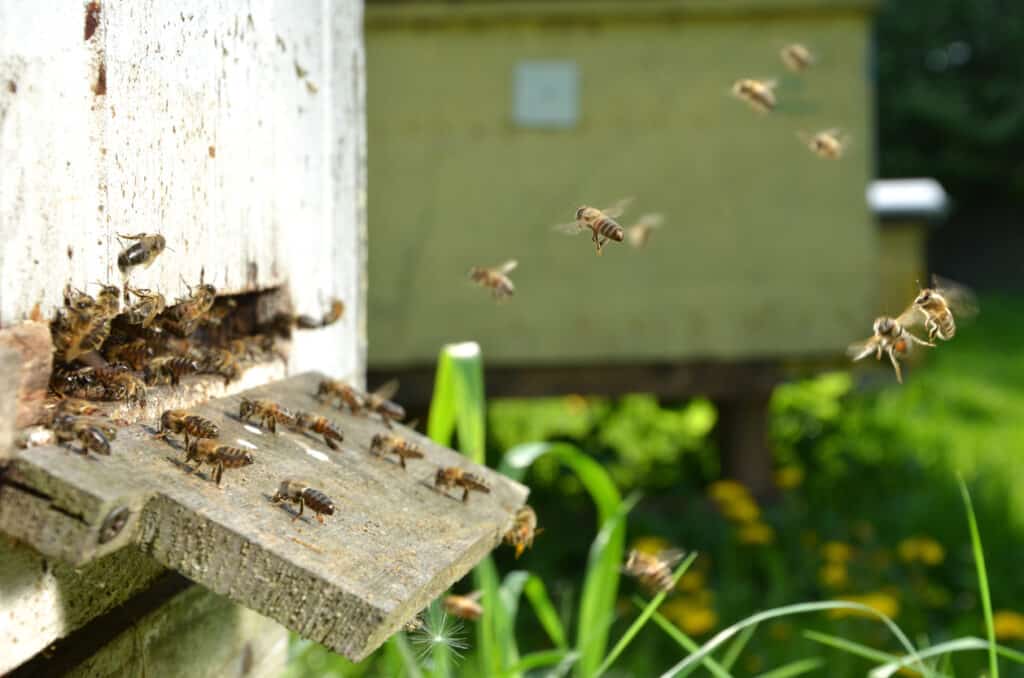
Since a drone bee does not have the capability or the responsibility to perform any duties within the beehive, what role does the drone play in the colony’s survival?
The sole role of the drone bee is to mate. This purpose is what the drone is designed for, and it has all the necessary physical features and attributes necessary to fulfill this task.
The drone is robust and strong to give the endurance required to undertake the sometimes long flights to drone gathering sites and compete with other drones to mate with virgin queens.
Is The Drone A King Bee?
Many people mistakenly consider a drone bee a king bee who lives in the colony and mates with the queen bee. This is not how the breeding habits of bees operate.
A queen bee remains in the beehive for most of her life and is tended to by worker bees who ensure all her needs are met so she can perform her egg-laying function.
A drone bee does not remain in the beehive, and his mating function is not even for his own colony. He will not mate with the resident queen and does not receive any special treatment from the worker bees during his adult life.
There are many drone bees in a colony, unlike the queen bee, of which there is only one in the colony. Consequently, there is no “king bee” in a honey bee colony.
The drone bee is not considered to be a king but rather a genetic carrier for the queen and the colony. The queen’s genetics will be carried in the drone and spread to other colonies when he mates with a virgin queen from a different colony.
Does A Drone Bee Do Any Work?
A drone bee does not do any work in the beehive. He does not have the apparatus to build wax comb, tend to bee larvae, produce honey, collect pollen and nectar or defend the hive.
However, his role is to propagate the genes from the resident queen and fertilize virgin queens from other colonies. This mating role is his only function, but it is important for the survival of bees as an insect species and propagating the genes from a strong queen to ensure genetic success in honeybees.
The only work drone bees have been observed participating in inside the hive is environmental control. The drones will participate in heating up the hive by vibrating muscles or cooling the hive by fanning their wings.
How Does The Drone Mate With A Queen Bee?
The mating process for honeybees is an interesting undertaking. The drone will not mate with the queen from his own colony since he is carrying her genes. The drone bee needs to seek out a virgin queen from a different colony with which to mate.
Drone bees from many colonies in the area will gather in drone congregation areas some distance from any active bee colonies. Science does not clearly understand how the drone congregation areas are selected and how the queens find these drone congregation areas.
Several thousand drones will be gathered at any congregation area, all ready to compete to mate with virgin queens seeking out the drones.
Since a mated queen will not leave the beehive, the number of queens available for mating is severely limited and require strong competition from the drones to be successful in mating. It is estimated that only 4% of drones ever get to mate with a queen.
The frequency and timing of drone flights to the assembly areas depend on the regional climate. Drones are mostly active in the congregational areas between midday and 5 pm, with the peak activity between 14h30 and 15h45.
This timing is because it is in the afternoons when the queens undertake a mating flight, and the hottest part of the afternoon is when potential predators are least active.
The drones may undertake several flights during the afternoon to and from the assembly area. They return to the hive to replenish their energy by eating honey.
Mating Is Fatal For A Drone Bee
The duration of each foray to the congregational area can be from 20 minutes per flight to up to 2.5 hours. The flight duration is largely dependent on the bee species.
Weather conditions influence mating flights, especially temperature, light intensity, and wind velocities. Mating occurs all year round in temperate climates but ceases altogether in regions with extremely cold winter seasons. Queen bees will not go out on a mating flight if the wind speed exceeds 11 mph or 18 kph.
The majority of honey bee species mate on the wing during flight. The queen bee will fly through the drone congregation area. The drone bees in the assembly area will compete, jostling each other in the air to get to the queen and mate with her.
The successful drone will approach the flying queen from the rear and slightly above the queen. He will come to rest on her abdomen and extend his genitalia to mate with her and deposit his sperm.
The mating process lasts several seconds, during which time the queen and the drone are joined by their genitalia. After mating, the drone bee dies and drops to the ground.
The queen bee will mate with between 12 and 15 drone bees until she is fully mated. If the queen is not fully mated on her first mating flight, she will undergo a second mating flight the same day or the next day. This will ensure she is fully mated and has sufficient sperm to lay eggs to produce workers and strengthen the colony.
Mating with several drones helps to ensure genetic diversity of the offspring and thus maintain a healthy genetic base in the colony.
[Embed YouTube Video: https://youtu.be/0WB0i1cSBWI ]
The Life Cycle Of A Drone Bee
A drone bee starts its life in the same way as any other bee, as an egg. The difference between the drone and other bee eggs is at the genetic level rather than the physical appearance level.
A drone egg is exactly the color and size, about half the length of a rice grain, of eggs for workers or queens. The genetic difference is that a drone egg is an unfertilized egg, meaning that a drone bee only has 16 chromosomes compared to the 32 chromosomes of worker and queen bees. As such, the drone bee has a mother but no father and only carries the genetic material of the queen.
The queen bee can control the laying of fertilized or non-fertilized eggs. This ability to choose gives her control of the number of drones and workers produced in a colony.
The drone egg is laid in a specially constructed wax cell that is larger than a worker cell and usually located on the lower corners of the brood comb. Capped drone brood is identified by the larger cell, and the cap covering the cell is domed above the level of the comb.
The drone egg hatches on the 3rd day to reveal a white, legless larva. The nurse bees feed the drone larvae with the same food as worker bee larvae; worker jelly, bee bread, and honey. The drone larvae are fed much larger quantities of food than a worker bee larva.
On the 10th day, the drone cell is stocked with a supply of food, and the cell is sealed or capped. The drone larva undergoes a prepupal stage and then a pupa, during which time it does not eat. The pupa will molt and emerge as an adult drone bee on day 24.
The new drone bee will remain in the hive for between 5 and 8 days after emerging. For the first few days, the young drone is fed by worker bees but then begins to feed by himself. He uses this time to eat and build up energy and reserves in preparation for the orientation and mating flights.
Drones undertake their first orientation flights around the beehive 8 days after emerging from their comb cells. The young drones will go out on their first mating flight 4 days after their first orientation flight since it is at this time that they will be sexually mature.
How Long Does A Drone Bee Live?
The drone bee has the shortest lifespan of any bee in the colony. Drones live for between 21 and 32 days during the summer months. Some drones can live up to 42 days, but their sexual viability diminishes after 28 days. Thus, an old drone bee may not be capable of mating with a queen and passing on his genes.
If a drone successfully mates, his lifespan will be on the shorter end of the scale since he will die immediately after mating with a queen.
In the cold winter months, the energy-hungry drones will be a drain on the colony’s resources, and there is no need for any drones during this season. Consequently, the worker bees will expel drone bees from the colony in the autumn, where the drones will die from the cold or starve to death.
The queen will begin to lay more drone eggs in the latter part of winter or early springtime to replenish the stock of drones in tome for the busy summer season.
Cold seasons are not the only time when drones may be expelled from the colony. If there is a dearth period during the summer, such as the rains arriving late, drones may be expelled to preserve the colony’s resources.
In climates where the winters are not harsh and there is sufficient food available, drones may be allowed to continue to exist in the hive.
How Many Drones Are In A Beehive?
The number of drones in a beehive will vary from season to season. The peak of the drone population in the hive will be during the summer months. The lowest drone population in the hive is during the winter months.
Drones are taxing on the colony’s reserves, which is why the queen limits the number of drone eggs that are laid and the reason the drones are expelled from the hive in autumn.
The drone population is usually a maximum of between 12% to 17% of the total bee population in the colony. This percentage indicates that in a colony of 60 000 bees, the number of drones could be between 7200 and 10 200.
The number of drone bees in a colony is often used as a diagnostic method by beekeepers to determine the health or problems in a bee colony.
If the number of drones appears to be above the 15 % mark, it could indicate a queenless colony. The beekeeper should actively search for the queen to establish if she is alive or whether a new queen or new brood must be introduced to save the colony from dying out.
A large number of drones in a bee colony can also indicate an unmated queen. This unfortunate situation can occur if bee populations in an area are low and the queen cannot find any drones to mate with on her mating flights.
This outcome will result in a queen that can only lay unfertilized eggs, which will produce drone brood only. If a beekeeper does not manage the colony, the colony will die unless a new queen is raised and manages to find a drone to mate with to produce fertilized eggs.
If a beekeeper manages the colony, the infertile queen can be removed, and a frame of brood with fertilized eggs can be introduced to the colony so the workers can raise a new queen.
Another alternative strategy is introducing a new, fertilized queen to the colony. These fertilized queens can be purchased from reputable queen breeders.
Do All Drones Come From The Queen?
The drones in a colony should all be the queen’s offspring in a healthy beehive. The queen bee will actively control the number of drones in the colony depending on the available resources in the beehive and the season.
If the queen is not healthy or has died, the pheromone she produces to prevent workers from laying eggs will not be strong enough or absent. The absence or weakness of the pheromone will stimulate worker bees to lay eggs, which is not a good situation in a colony.
The worker bees will only be able to lay unfertilized eggs, which will result in a spike in the drone population in the hive.
Drones in large numbers in a colony will deplete the colony’s food reserves, resulting in the colony’s demise unless a queen can be raised by the workers or introduced to the colony by the beekeeper.
The only benefit of a large number of drones in a failing bee colony is that the genetic material of the colony will be passed on to virgin queens with whom the drones will mate. This ensures the genetic material from the colony is not lost to the local bee population, even if the queen has died and the colony is doomed.
Conclusion
Drone bees are the only male bees in a colony, and their purpose has little to do with the day-to-day functioning of the colony.
The drone’s function does not directly affect the drone’s colony but impacts the survival of local bee colonies in the area.
The drones from various colonies will congregate in certain areas and mate with virgin queens from bee colonies in the surrounding area. After mating with a queen, the drone will die.
Even though drones do not contribute directly to the colony’s survival, their role is important to the survival and genetic diversity of the greater bee population in the area.
References
